Restricted heterochromatin formation links NFATc2 repressor activity with growth promotion in pancreatic cancer
- PMID: 22079596
- PMCID: PMC3626431
- DOI: 10.1053/j.gastro.2011.11.001
Restricted heterochromatin formation links NFATc2 repressor activity with growth promotion in pancreatic cancer
Abstract
Background & aims: Transcriptional silencing of the p15(INK4b) tumor suppressor pathway overcomes cellular protection against unrestrained proliferation in cancer. Here we show a novel pathway involving the oncogenic transcription factor nuclear factor of activated T cells (NFAT) c2 targeting a p15(INK4b)-mediated failsafe mechanism to promote pancreatic cancer tumor growth.
Methods: Immunohistochemistry, real-time polymerase chain reaction, immunoblotting, and immunofluorescence microscopy were used for expression studies. Cancer growth was assessed in vitro by [(3)H]thymidine incorporation, colony formation assays, and in vivo using xenograft tumor models. Protein-protein interactions, promoter regulation, and local histone modifications were analyzed by immunoprecipitation, DNA pull-down, reporter, and chromatin immunoprecipitation assays.
Results: Our study uncovered induction of NFATc2 in late-stage pancreatic intraepithelial neoplasia lesions with increased expression in tumor cell nuclei of advanced cancers. In the nucleus, NFATc2 targets the p15(INK4b) promoter for inducible heterochromatin formation and silencing. NFATc2 binding to its cognate promoter site induces stepwise recruitment of the histone methyltransferase Suv39H1, causes local H3K9 trimethylation, and allows docking of heterochromatin protein HP1γ to the repressor complex. Conversely, inactivation of NFATc2 disrupts this repressor complex assembly and local heterochromatin formation, resulting in restoration of p15(INK4b) expression and inhibition of pancreatic cancer growth in vitro and in vivo.
Conclusions: Here we describe a novel mechanism for NFATc2-mediated gene regulation and identify a functional link among its repressor activity, the silencing of the suppressor pathway p15(INK4b), and its pancreatic cancer growth regulatory functions. Thus, we provide evidence that inactivation of oncogenic NFATc2 might be an attractive strategy in treatment of pancreatic cancer.
Copyright © 2012 AGA Institute. Published by Elsevier Inc. All rights reserved.
Figures
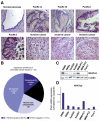

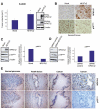
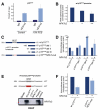
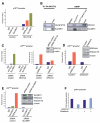
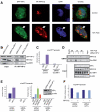

Similar articles
-
NFAT-induced histone acetylation relay switch promotes c-Myc-dependent growth in pancreatic cancer cells.Gastroenterology. 2010 Mar;138(3):1189-99.e1-2. doi: 10.1053/j.gastro.2009.10.045. Epub 2009 Nov 6. Gastroenterology. 2010. PMID: 19900447 Free PMC article.
-
GSK-3β Governs Inflammation-Induced NFATc2 Signaling Hubs to Promote Pancreatic Cancer Progression.Mol Cancer Ther. 2016 Mar;15(3):491-502. doi: 10.1158/1535-7163.MCT-15-0309. Epub 2016 Jan 28. Mol Cancer Ther. 2016. PMID: 26823495 Free PMC article.
-
Suppression of tumorigenesis and induction of p15(ink4b) by Smad4/DPC4 in human pancreatic cancer cells.Clin Cancer Res. 2002 Nov;8(11):3628-38. Clin Cancer Res. 2002. PMID: 12429655
-
Interaction between NFATc2 and the transcription factor Sp1 in pancreatic carcinoma cells PaTu 8988t.BMC Mol Biol. 2017 Aug 3;18(1):20. doi: 10.1186/s12867-017-0097-9. BMC Mol Biol. 2017. PMID: 28774282 Free PMC article.
-
Trisomy of the Dscr1 gene suppresses early progression of pancreatic intraepithelial neoplasia driven by oncogenic Kras.Biochem Biophys Res Commun. 2013 Oct 11;440(1):50-5. doi: 10.1016/j.bbrc.2013.09.033. Epub 2013 Sep 13. Biochem Biophys Res Commun. 2013. PMID: 24041692
Cited by
-
Heterochromatin Protein 1: A Multiplayer in Cancer Progression.Cancers (Basel). 2022 Feb 1;14(3):763. doi: 10.3390/cancers14030763. Cancers (Basel). 2022. PMID: 35159030 Free PMC article. Review.
-
Insights into the epigenetic mechanisms controlling pancreatic carcinogenesis.Cancer Lett. 2013 Jan 28;328(2):212-21. doi: 10.1016/j.canlet.2012.10.005. Epub 2012 Oct 13. Cancer Lett. 2013. PMID: 23073473 Free PMC article. Review.
-
A multistep high-content screening approach to identify novel functionally relevant target genes in pancreatic cancer.PLoS One. 2015 Apr 7;10(4):e0122946. doi: 10.1371/journal.pone.0122946. eCollection 2015. PLoS One. 2015. PMID: 25849100 Free PMC article.
-
Molecular detection and targeting of EWSR1 fusion transcripts in soft tissue tumors.Med Oncol. 2013 Mar;30(1):412. doi: 10.1007/s12032-012-0412-8. Epub 2013 Jan 18. Med Oncol. 2013. PMID: 23329308 Free PMC article. Review.
-
A Novel Prognostic Four-Gene Signature of Breast Cancer Identified by Integrated Bioinformatics Analysis.Dis Markers. 2022 Feb 27;2022:5925982. doi: 10.1155/2022/5925982. eCollection 2022. Dis Markers. 2022. PMID: 35265226 Free PMC article.
References
-
- Hidalgo M, Maitra A. The hedgehog pathway and pancreatic cancer. N Engl J Med. 2009;361:2094–2096. - PubMed
-
- Singh M, Maitra A. Precursor lesions of pancreatic cancer: molecular pathology and clinical implications. Pancreatology. 2007;7:9–19. - PubMed
-
- Kim WY, Sharpless NE. The regulation of INK4/ARF in cancer and aging. Cell. 2006;127:265–275. - PubMed
-
- Gil J, Peters G. Regulation of the INK4b-ARF-INK4a tumour suppressor locus: all for one or one for all. Nat Rev Mol Cell Biol. 2006;7:667–677. - PubMed
Publication types
MeSH terms
Substances
Grants and funding
LinkOut - more resources
Full Text Sources
Medical
Miscellaneous

